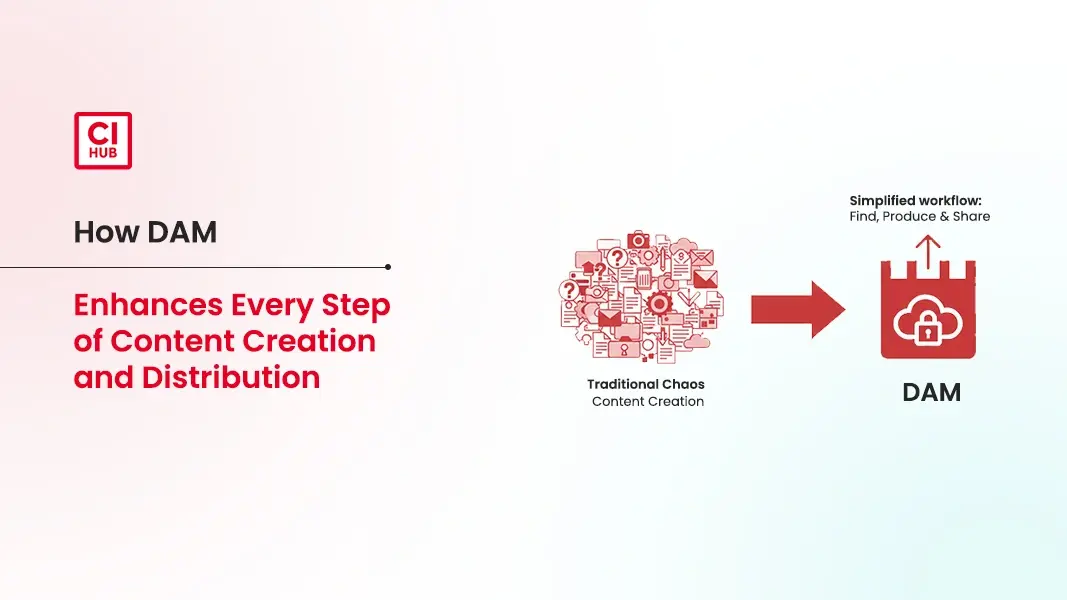
September 30, 2025
How DAM Enhances Every Step of Content Creation and Distribution
TL;DR
Digital Asset Management (DAM) streamlines every stage of content creation and distribution. It centralizes assets, ensures version control, supports collaboration, and enables fast, consistent content delivery. Integrations like the CI HUB Connector allow teams to access assets directly within their creative and marketing tools, making workflows more efficient and reducing errors. Organizations using DAM can produce high-quality, on-brand content faster while improving productivity and team alignment.
Introduction
Content demands are growing at an incredible pace. Recent data shows that 90% of marketers use blog content to meet their marketing goals, and more than three-quarters (77%) of marketers utilize social video, indicating a massive flow of images, videos, and documents being created daily. Without the right system, assets get lost, outdated files resurface, and projects slow down.
This is where Digital Asset Management (DAM) steps in. It’s more than a storage space; it’s a central hub that keeps assets organized, ensures version accuracy, and simplifies content delivery. With DAM, teams can focus less on file chaos and more on creating impactful campaigns.
In this blog, we will discuss:
- Why DAM is Essential for Content Creation
- Step-by-Step Impact of DAM Throughout the Content Lifecycle
- DAM Use Cases for Marketing Teams and Agencies
- Choosing the Right DAM
- Conclusion
Why DAM is Essential for Content Creation
Modern marketing teams produce content across multiple channels, including web, social, email, and more. Without a centralized system, valuable assets can be scattered, duplicated, or delayed, slowing down campaigns and creating inconsistencies. This leads to issues like:
- Disorganized storage: Assets kept in different platforms or local drives are harder to locate and manage.
- Inconsistent versions: Teams may work with outdated files, risking errors in campaigns.
- Delayed approvals: Reviewing and approving assets across multiple tools can create bottlenecks.
A Digital Asset Management system provides a single source of truth, connecting teams, standardizing assets, and enabling faster, more reliable content creation and delivery.
Step-by-Step Impact of DAM Throughout the Content Lifecycle
Efficient content creation and distribution depend on structured processes. A DAM supports every stage, ensuring teams work smarter, faster, and more consistently.
Ideation and Planning
During the planning phase, teams need access to inspiration and reference materials to develop strong concepts. DAM streamlines this stage by:
- Providing a central library of templates, past campaign assets, and brand guidelines.
- Allowing team members to search, filter, and reference approved content quickly.
- Reducing time spent hunting for assets and aligning ideas with brand standards.
With these capabilities, teams can start projects confidently, ensuring all creative work begins with accurate and relevant resources.
Content Creation and Collaboration
Once ideas are planned, the focus shifts to producing and refining content. DAM plays a key role by:
- Ensuring all team members have access to the latest version of assets, reducing duplicate or outdated work.
- Enabling real-time collaboration, including commenting, annotations, and approvals directly within the platform.
- Integrating with creative tools to streamline asset usage without switching between multiple systems.
By centralizing content and collaboration, DAM keeps creative teams aligned, speeds up production, and maintains consistent quality across all assets.
Streamlining Creative Workflows
A DAM simplifies workflows and automates repetitive tasks. It supports creative efficiency by:
- Automating notifications for deadlines, reviews, and approvals.
- Allowing bulk editing, file transformations, and format conversions on the fly.
- Tracking tasks and asset usage to identify and prevent bottlenecks.
Teams spend less time on administrative work and more on high-value creative activities.

Ensuring Consistency and Brand Control
Maintaining brand integrity across content is essential. DAM ensures brand consistency by:
- Acting as a single source of truth for assets, templates, and brand guidelines.
- Automating permissions and access control to manage content rights and usage.
- Flagging outdated or unapproved assets before they are used in campaigns.
This guarantees content is always on-brand and compliant, regardless of team size or location.
Distribution Across Every Channel
DAM simplifies the final stage: delivering content efficiently. It supports distribution by:
- Enabling one-click publishing to multiple digital and print channels.
- Integrating seamlessly with CMS, marketing platforms, and creative tools.
- Keeping all distributed content tracked and aligned with the latest brand standards.
Teams can deliver content faster, accurately, and across every channel without manual errors.
Measurement and Optimization
Tracking content performance is critical for ongoing improvement. DAM provides insights by:
- Offering analytics on asset usage, engagement, and performance.
- Highlighting which content resonates and which assets are underutilized.
- Enabling teams to refine workflows and content strategies based on data.
This transforms the DAM from a storage hub into a strategic tool that drives smarter, more effective content creation and distribution.
DAM Use Cases for Marketing Teams and Agencies
Marketing teams and agencies work under constant pressure to deliver faster, better, and more consistent campaigns. Digital Asset Management (DAM) makes this possible by streamlining access, collaboration, and control of creative assets. Here’s how it helps in practice:
Accelerated Campaign Launches
With a centralized asset library, teams no longer waste time searching for files or recreating existing designs. Ready-to-use templates and automated workflows ensure campaigns move quickly from planning to launch, cutting approval cycles and time-to-market.
Maintaining Brand Compliance Across Distributed Teams
DAM serves as the single source of truth for logos, templates, and brand guidelines. By controlling permissions and ensuring only approved files are available, marketing teams worldwide stay aligned. This reduces errors and strengthens brand identity across all touchpoints.
Quick Localization and Adaptation for Global Campaigns
For global companies, DAM makes localization much smoother. Regional teams can access pre-approved templates, adapt them to their markets, and still remain compliant with brand standards. This approach saves time and reduces mistakes in translation or design.
Applications in Agencies, Enterprises, and Content-Heavy Industries
Agencies benefit from DAM by managing multiple client campaigns without version confusion. Large enterprises scale their content production efficiently across different departments and geographies. Content-heavy industries like e-commerce or publishing can store, update, and distribute thousands of assets in a structured, searchable way.
Real-life Case Study
Ansira, a global marketing firm managing assets for 500+ brands, faced version mismatches and disconnected workflows. By integrating Acquia DAM with Adobe InDesign via the CI HUB Connector Professional, designers could access live, approved assets instantly. This streamlined collaboration eliminated duplication and ensured consistent branding across the globe. The result: over 130,000 designs produced annually with a 98% satisfaction rating on turnaround times.
Learn more about how CI HUB helps Ansira offer creative efficiency and brand consistency.
Choosing the Right DAM
Selecting the right Digital Asset Management system is crucial for smooth content creation and distribution. Look for features like seamless integration with creative and marketing tools, scalability to support growing teams and asset volumes, built-in collaboration tools for real-time teamwork, and analytics to track asset usage and performance.
For professional content workflows, consider a DAM that works with connectors like the CI HUB Connector. This enables direct access to assets within familiar applications, streamlines asset management, and keeps teams aligned, all while maintaining control and efficiency.
Conclusion
A Digital Asset Management system transforms how marketing teams and agencies handle content. It centralizes assets, maintains version control, and enables smooth collaboration, reducing delays and errors.
From planning and creation to distribution and performance tracking, every stage benefits from a structured, accessible system. Using tools like the CI HUB Connector further improves workflows by giving teams direct access to assets within the applications they already use. Implementing DAM helps organizations deliver consistent, high-quality content efficiently and keep projects on track.
Frequently Asked Questions
Digital asset management (DAM) is a process and technology that helps organizations organize, store, retrieve, and share digital files like images and videos. It ensures every asset stays accessible, secure, and up-to-date throughout its entire content lifecycle.
To get better at content creation, focus on making content that feels authentic to your style and personality instead of copying trends that don’t fit you. When content is true to who you are, audiences are much more likely to find it relatable and engaging.
The "4 E's" of content creation are Educate, Entertain, Engage, and Empower, and they guide creators to make content that resonates and inspires audience participation. By balancing these elements, brands build loyalty and authority without relying solely on selling.

Article by
Michael Wilkinson
Marketing & Communications Consultant of CI HUB